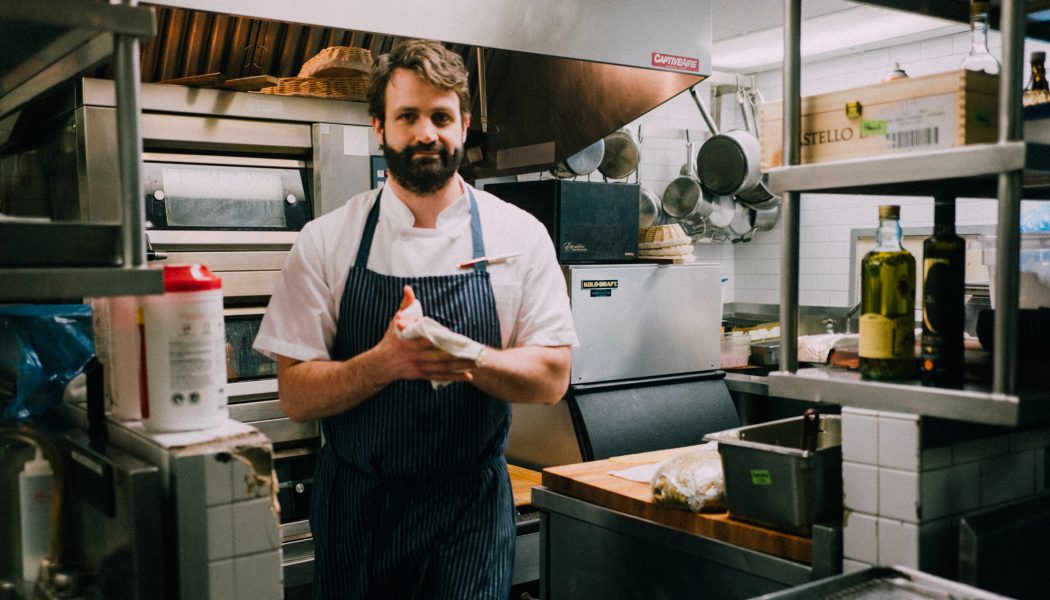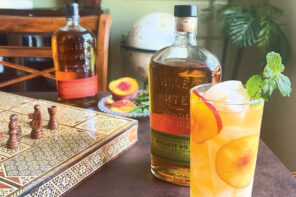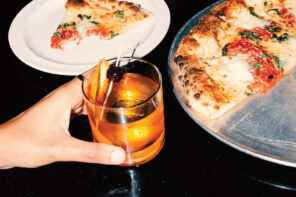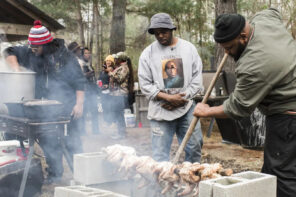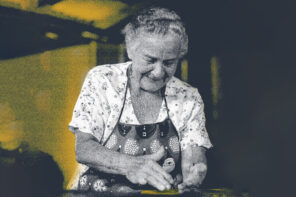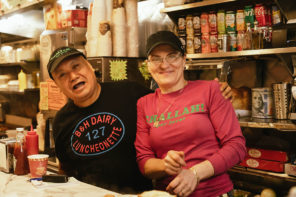Breaking Bread
Unless you go way back, we’re talking like a millennia, more people are baking more bread at home than ever. With the renewed interest in baking thanks to the you-know-what more people are getting into their flours. But not all flours are created equal. Bread isn’t just about baking any more than a glass of wine is only about how long it spent in the barrel or a cup of coffee is about only the pot you brewed it in.
Enter the fresh-milled milieu.
Adam Leonti is a chef, master baker and the flour guru who’s put fresh milled flour back into practice. He literally wrote the book, Flour Lab, on milling grain at home and using it wisely. He was the chef at Vetri in Philadelphia before opening his eponymous Leonti restaurant in NYC. He chats with his longtime friend and former business partner Michael Wilson about our newfound passion for baking bread, why sourdough probably shouldn’t be the first bread you make and if you can really live on bread and water alone.
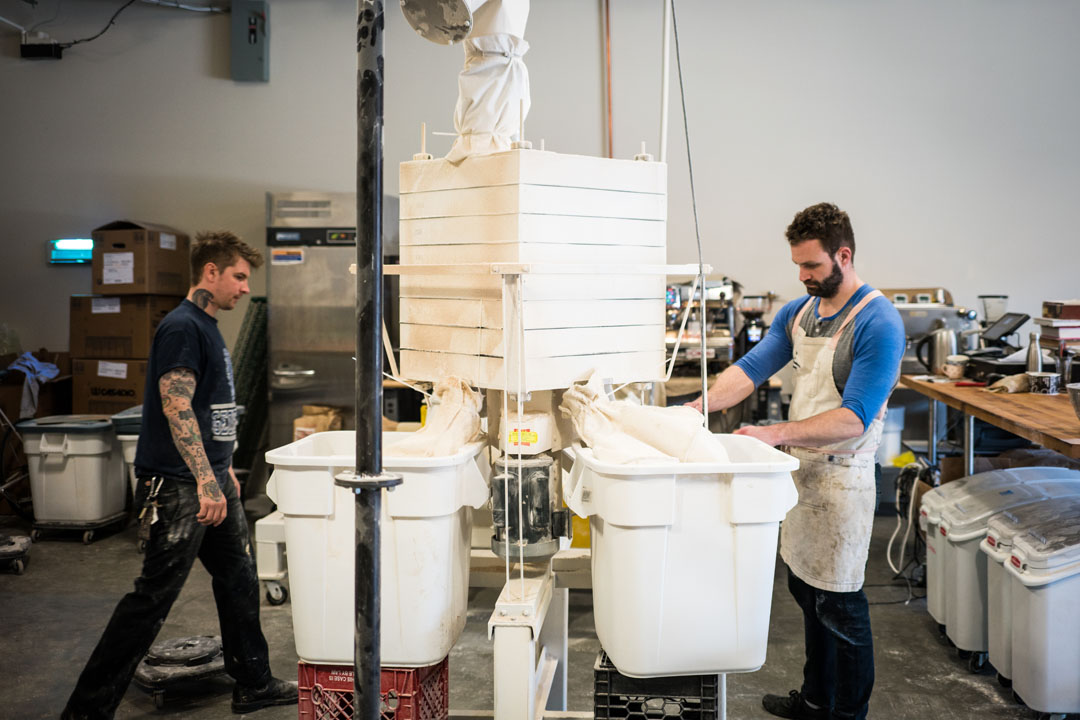
All photos by Chris Rubino
Michael Wilson: Let’s talk about milling flour, and different grains, and how grain plays into bread making. Your thoughts might give people a different perspective … that bread isn’t just about baking. It’s about what goes into the dough, and not just about time and temperature, but the flour itself. You don’t have to dig in too deep, even though I know you will, but let’s chat about how you started milling, and why.
Adam Leonti: I started milling flour as part of my larger ethos in the kitchen. I was a chef before I got serious about baking. And my ethos has always been that of chef, and the cuisine that comes from Italy. And anyway, the idea is that Italian chefs, and think I think other cultures would agree with it too, primarily to look at sourcing food, and then collect the best ingredients on the plate.
When I was the chef of a Vetri restaurant in Philadelphia about 10 years ago, one of the things that I felt needed adjustment was our breads, and pastas. A light bulb clicked on for me when I read Paul Bertolli’s book, Cooking By Hand, where he had a little hand mill, and started milling to make different pasta doughs. And I thought that was really interesting. So, I went and got a mill from a local shop in Philly. And my journey started there—visiting universities, and bakers that were far more experienced than me. I started to get the results in the kitchen I was looking for, and couldn’t have imagined from the beginning just how impactful they were … how much fresh-milled flour improved taste and quality.
MW: How so?
AL: I always try to equate it to coffee. Having a coffee of my parents’ generation, like Folgers, or something like that, sold in s vacuum sealed bag that was pre-ground months or years ago, versus to the espresso culture of today, where coffee is ground to order. The flavor difference is significant. That happens with the grains. And milling them fresh really improved the flavor—far beyond the whole wheat available in the stores. Those commercial flours actually taste rancid, and aren’t desirable, compared to what I was noticing, when I started to mill flour to make bread, and pasta, and cakes.
MW: Do you mean you’re able to taste the flavors profiles of different grains? What are you after?
AL: You know how when you eat, say, a sourdough bread from something that wasn’t milled fresh, it tastes sour. That’s all you taste. Whereas if you make a sourdough bread with fresh milled grain, there’s a provenance to each grain, and there’s a whole flavor complexity to each one. So, there’s a grain that grows in the Arizona desert, called Sonora, that I use a lot. It’s from Mexico originally. It’s been grown for so long out West, and when you smell it, it actually smells when it’s freshly milled, and put water in with it to make dough, it starts to smell like milk, which is incredible.
There’s a wheat, a hard winter wheat grown in New York State called Redeemer, each one of the wheats have such unique names. Sometimes they’re based on where they’re from, but also it’s based on the scientist who bred it, and was able to get it to grow. Redeemer wheat tastes really hearty. Hearty in a sense that it’s very noticeable. It’s very strong as soon as you mill it. It’s very floral, full of perfume, and intense. When you let it ferment and turn it into a dough, you can smell it across the room in a kitchen which has an exhaust system. All of these things, all these qualities, completely evaporate as the flours age.
The flour that you buy in a store may be a combination of seven to ten different wheats to make a multi-purpose blend. Then it just sits on a shelf. Each grain’s inherent flavor goes away, and the mix simply has that nonexistent ‘flour flavor.’ You know? It tastes floury, versus it tastes like milk, or it tastes like cinnamon, or honey, or how Redeemer wheat smells like honey. Those kind of aromatics. Much like wine.
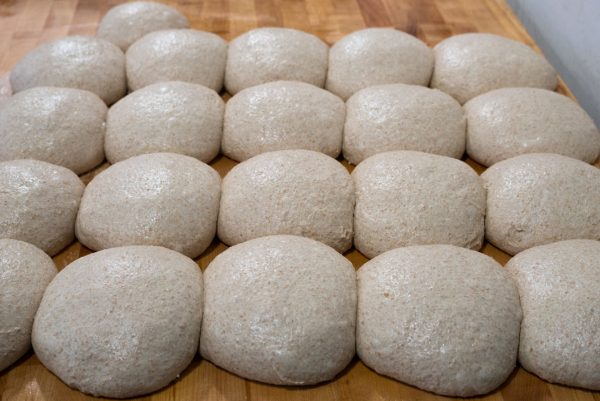
MW: Yeah so, if someone’s a home baker, a novice home baker, who wants to experiment with fresh milled flour in their recipes, how do they go about even getting started on that? Other than buying your Flour Lab book.
AL: Yeah, that was an easy advert. So, for the person who is going to treat bread making at their house as a real hobby, like a real source of joy, other than television, or reading or something. It’s got to be your thing. I would first invest in a small counter-top mill. There are a few options online. They have become more and more affordable. So, if you invest in your skis every five years, think of it like that, like it’s a sport, or it’s a real source of pleasure. Then the cost really seems minimal in comparison to a ski lift ticket. So, for about 200 bucks, you can get a small mill for your home, with a composite stone. Just make sure that it’s a stone mill versus a metal steel plate. The stone really makes a difference.
You can get grains online from all over the world. Because the grain is dried, its quality doesn’t diminish. So it’s not like a tomato, or something that really should be locally sourced. Wheat actually does better in different climates than others. So I really try to, again, think of it like coffee. How peculiar it would be if you’re like, “This is my New York State-grown Arabica beans.” It’s probably not going to be your favorite Arabica bean to make coffee. So don’t worry about how far it’s traveled. You’re supporting that farm and that culture, so it’s a good thing.
If you go online, you can find different grains. And a lot of times they’ll tell you that these grains are good for making bread right away. If you’re in New York, you can go to grownyc.com. Hayden Flour Mill is another one out in Arizona that gets you the Sonora wheat, I talked about earlier. Small Valley Mill is in Pennsylvania. There’s a number of places to look at. So get the mill, get the grain. I would start by making a yeasted product, instead of a sourdough. You want to work each variable through independently before you put them all together. You don’t want your success rate to be based on mastering sourdough on top of mastering milling. So, take one at a time.
Imagine being a surfer who just bought a board and then you walk out into the ocean and try to surf double overhead waves the first day.
MW:Everyone seems to want to do sourdough right now. Is that advisable?
AL: Oh, it’s crazy. Well, imagine being a surfer who just bought a board and then you walk out into the ocean and try to surf double overhead waves the first day. You really need some tutelage, and practice. You know? And then you grow into it.
MW: And what’s the difference? Why is it so much more complicated to be successful with sourdough .. generally speaking?
AL: Both sourdough and the store-bought yeast are yeasts, just one has been cultivated in a stable form (It’s also a monopole of culture). It’s not as complex as the sourdough, and it is certainly more predictable. It seems like people are very interested the health benefits that come with sourdough. People are new to something that’s existed for so long. They really tend to grasp for the extremes. So, go back to coffee, when coffee came into the US as the microbrew version of it, people really wanted acidity, and sourness in their coffee. These were completely off-the-wall desires to cultures that have had high-quality coffee for so long, where they’re looking more for fruit, and balanced flavors.
And you equate quality, sometimes I think Americans do, with that extreme. And with it being like, “It has to be sourdough, or it’s not quality.” When the reality is the baguettes that travelers have in Paris, those are made with yeast. Even if they’re made with a little bit of sourdough, they’re really actually fueled by yeast. Almost no one makes a 100% sourdough baguette. You’d have to really search to find that, and I bet you wouldn’t like it as much compared to the others.
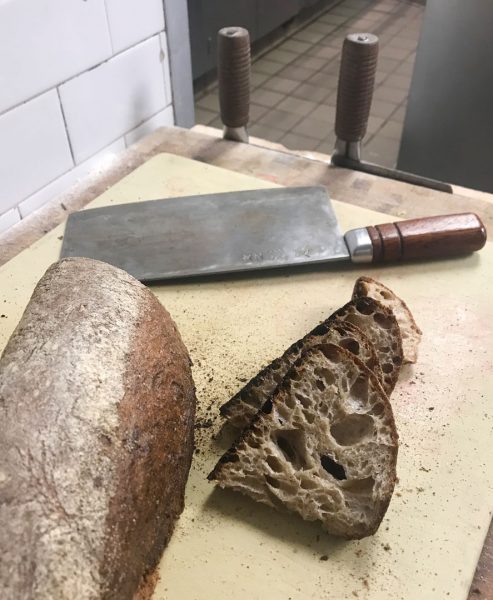
MW: But what makes sourdough so complicated to work with?
AL: The sourdough yeast, the starter that causes the dough to ferment, rise, etc. So, you basically are acquiring a pet now. You now have a starter pet in your house, and you have to pay attention to it, or it’ll get sick. You have to have an understanding of a fungal culture, and how to keep it healthy. So that’s part of why it’s so hard, is that you’re keeping alive this thing that can’t necessarily just be put in the fridge, and come out when you want it to on the few times a month that you’re going to bake bread. Sourdough and sourdough culture went away because people didn’t make bread every single day. You know? It just wasn’t the way to do it. And it becomes obvious after a while. And then you’re like, “Oh, I don’t want to have to throw this out, this little bit of flour and water every day if I’m not making bread.” And the way to not throw it out is to literally make bread every single day.
Because at a certain point, when enough people are discussing their diet at the table instead of, say, a movie they saw, it gets annoying.
MW: There certainly seems to be a bread revolution, even before people were stuck at home. It seems to be that, and maybe it’s the popularity of back-to-local artisanal products. How do you think you fit into that?
AL: These are clearly just my own thoughts and none of this is scientific. But the world is very reactionary, right? So, before the bread revolution was the anti-bread revolution. And Atkins of the late 90s, and the early aughts, moving into keto, and moving into carbohydrates being the devil to your most narcissistic side, which then created symptoms of ailments, that always come with different allergies and whatnot. But it was really the anti-bread movement that feeds the bread movement. Because at a certain point, when enough people are discussing their diet at the table instead of, say, a movie they saw, it gets annoying.
And so I think enough people had heard enough people saying, “I’m gluten-free,” that it was like, well now the counterculture is to be, I eat gluten.” And I feel like it became counterculture, and then counterculture becomes mainstream. And hopefully from the anti-bread movement, to the bread movement, we’ll get to a place, almost to speak before about how coffee changed and most people drink better coffee today than they drank a decade ago. When I was at Vetri, I was nervous actually running the restaurant with the amount of guests that were gluten free, because my livelihood was pasta, and gluten, and I really was nervous that maybe that trend would diminish Italian restaurants.
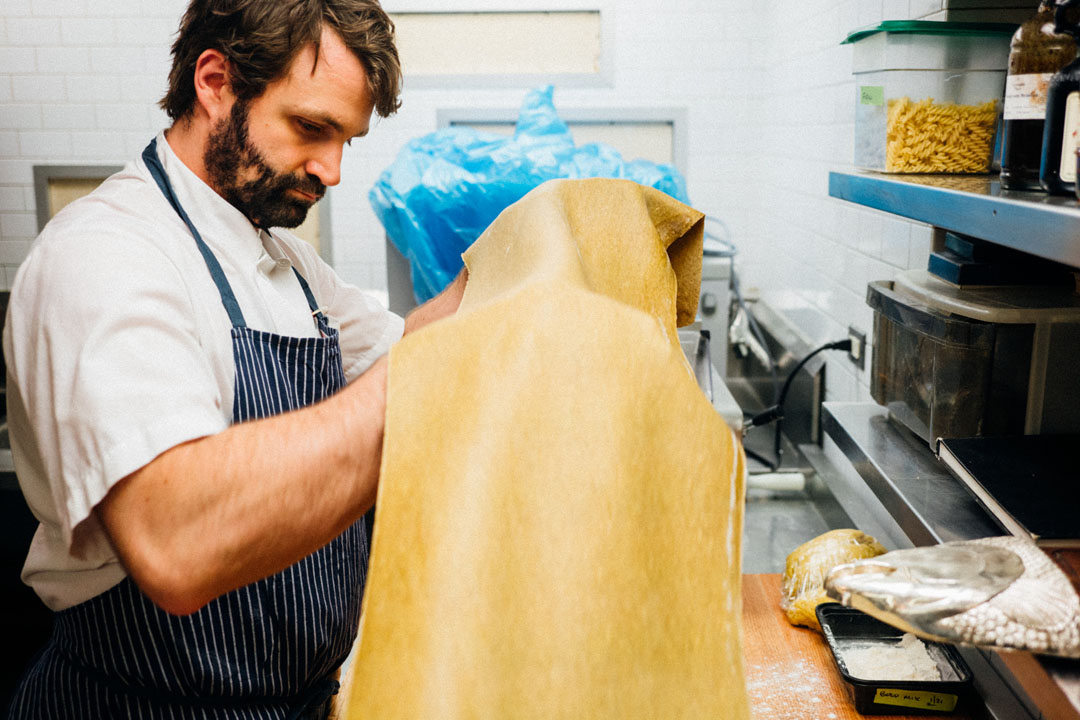
MW: And how does fresh milled flour stack up in the context of people’s gluten concerns, you know? Is it healthier?
AL: Well, if they really have a gluten allergy, or have an autoimmune disease like celiac, then they shouldn’t touch it no matter what. No matter how it’s handled. If someone has what is called a gluten sensitivity, or maybe what some people have been calling a wheat sensitivity. There is no answer to 100% why that happens, but people do believe it comes from pesticides, and how grains are grown. By having an organic product that’s been freshly handled, then you could see your symptoms go away, in which case you could enjoy things that you like, because it’s not filled with Roundup or things like that.
MW: On the nutrition side, does the fresh milled, unbleached, flour, retain a lot of its natural oils, and its natural nutrition?
AL: Yeah, yeah. Good point. So say you have none of those symptoms and you just eat deli bread from the deli, and you’re one of those people that doesn’t even think twice about it. But the reality is your health will improve, that’s a part of your diet, by having a fresh milled wheat product, because you’re going to get enzymes that are now activated and alive, that contribute to your digestion. You’ll get bran, which is usually extracted in most flours, which is full of fiber, and folic acid, and things that also improve your health. Bran is something that continuously, from the research that I’ve read and been exposed to, is something that a lot of people are lacking, is in fiber. And bran is n easy, easy way to get it into your diet in an enjoyable way.
Fresh milled products contain a myriad of things that are good for you. If you team it up with wild yeast, the wild yeast you make sourdough with, versus the store-bought yeast, it unlocks even more health benefits. And of course, the science can be ambiguous. But from the scientists that I was lucky enough to work with at Washington State University and learn from, they really couldn’t emphasize more how important the sourdough fermentation to these fresh milled wheats really gave more nutrition into the food than anything else.
MW: Yeah, and I guess it carries all that nutrition that all gets wiped away in the processing. Maybe you can actually live on bread and water, right?
AL: You 100% can. Sourdough bread, you could eat exclusively, and you would be able to sustain life.
Wheat got people from the wilderness into civilization.
MW: The breads and pastries that you have been making in your restaurants, they definitely could have their own… I mean, they deserve their own bakery. It’s as good as you can get, by many people’s standards. But your choice was not to run a bakery, but to have your bread be part of some bigger restaurant experience. There’s not a lot of people that know how to bake, and make bread products the way you do, and the ones that do are exclusively bakers. So why not have a bakery?
AL: One of the things that has continued to fascinate me, and make me interested in what I do, is the simple idea that grains, and wheat specifically, is the little tiny seed that took people from being a hunter and gathering lifestyle, which we call lifestyle, into real agriculture, and real sustained nourishment. And that’s very basic. Wheat got people from the wilderness into civilization. And then over time there was cultural erosion, and I say the word erosion not in a way that it’s diminishing, but an erosion in the way that glaciers scraped the surface of the earth of time, and from the pressure of using these products, sophisticated cuisines are created.
And if you look at cuisines from China, to the Middle East, to Italy, to the West, wheat is such a massive part of each cuisine, of all cuisines. And it is simply there because it has so many magical properties. It can capture air, which is insane, through gluten. It’s full of vitamins and minerals. It grows almost everywhere. It goes in every single state in the United States. And it can grow in the desert. It can grow in cold climate. It grows everywhere, which is so helpful. And then also the amount of calories that it produces, the amount of energy it produces per acre, is one of the highest there is of anything, which is speaking to meat, and speaking to some things that we really spent a lot of time on, a lot of land on.
So, this magical crop, through culture developing, made its way onto the table, and rightfully so, in almost every course. From bread in the beginning, to pasta in the middle, to a dumpling, or to somehow an entree at the end. It’s ubiquitous in the cuisine that I chose to study, and the more I knew about it, the more I wanted to incorporate it, and honor that, and honor its tradition. And honor its development through recipes, and through people finding a common taste for their recipes, and things that they really loved, and held on to.
By keeping it in the restaurant, instead of trying to have it be exclusive to itself, I thought, I think, that it speaks to it as being interwoven into food experiences altogether. So it becomes each course. It’s in each thing, and it’s around always. It’s always part of a meal, and again, in each course, so that impact for me, I think, attention would be drawn more to a restaurant than a bakery. Because bakeries usually just more or less fill the bread section. I’m sure bakeries offer a sandwich that you can take with you or something. But whereas a restaurant, you have the ability to have grains stewed, and you have grains become soups, and you have them become all of these things I was talking about before, and that to me is just really fascinating and, I think, pretty special.
MW: Yeah, I guess part of it is that in most great restaurants, the bread has to be good, but it’s not the focus of the meal and also you can have a great restaurant with mediocre bread, and no one thinks twice about it.
AL: Yeah, and because I don’t want it to be a throwaway, because there shouldn’t be a throwaway anymore. That’s kind of our issue, as a society, is that certain things can be… We’re okay with certain things being not important, and I don’t think food on table should fit that category, you know?
MW: All right, this is my last question, and it’s the big one: butter or olive oil?
AL: Oh, well, you and I were trying to figure out how to get butter and olive oil to make a baby once.
I think it’s certain circumstances. I think it’s time and place. If I were hanging out in Provence, and drinking rosé, I’m going to want some butter with some flakey salt. But if I was hanging out in Greece, island hopping, I’m going to want that fat olive flavor from olive oil. So I guess both is the answer. Yeah, I think it’s, yeah, you can’t choose. It’s like what arm would you rather have removed?
MW: Neither.

